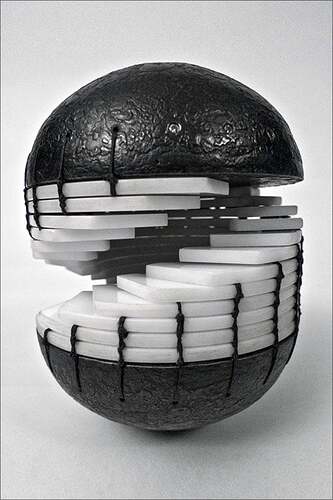Materials: Steel, acrylic, linen, cubic zirconia
Dimensions: 4.5" x 6" x 4.5"
I work to created forms that restrict access to its contained information. As this is a book form, content is implied but the circular stitching does not allow the piece to be opened; only the inner cylindrical chamber can be viewed.
Photo credit: Benjamin Dory
Benjamin Dory
Carbondale, IL. USA
I am fascinated by the ability to transform a surface through pattern. The methods with which to do this are infinite, and I am most fascinated by using modular or repeated forms to create new visual textures. I strive to maintain a clean, simplified, and minimal line quality. Symmetrical polygons, mathematical constructions, and grid systems act as structural imagery. My aim is to create unified, pleasing compositions that appeal to the viewer on a subconscious level.
I am currently a MFA Candidate at Southern Illinois University Carbondale. I began metalsmithing at the University of Kansas. In 2007 I culminated my BFA from Kansas by studying abroad in the silversmithing department at Lahti Polytechnic in Lahti, FInland. The Penland School of Craft and Revere Academy of Jewelry Arts have also played pivotal roles in my development as a metalsmith.
These containers and vessels definitely hold their place in the world of stunning art objects as well as in the world of metalsmithing.
Since the dawn of time humans have created containers to hold things that were important to them, from large vessels to hold food and harvests to intimate containers for small precious things. They might hold memories, ashes, medicine, beverage, fruit or food - but all spring from the imagination and skill of the maker. Some have specific religious functions, some are meant for everyday use. When one thinks of a vessel or container the inclination is to think of something with solid walls - yet many of these works involve the exploration of positive and negative space, and the use of negative space to help create the illusion of the wall of the vessel.
As the world’s largest jewelry related internet site, Ganoksin strives to develop exhibitions showcasing work from around the world. This exhibition was open to all metalsmiths, professional and amateur, advanced and beginner. Participants are from The Netherlands, the USA, Canada, Australia, Costa Rica, the United Kingdom, Israel, Hong Kong, Colombia, Romania, Italy, Ireland, Japan, Malaysia and Denmark. While most of the pieces are by an individual metalsmith, some are collaborations, one of three artists spanning 50 years.
In total 319 artists contributed 729 show pieces for the permanent online exhibition.
Objects in the exhibition include boxes, lockets, urns, ash containers, bowls, wine cups, reliquaries, match holders, vases, teapots, pitchers, sugar bowls, baskets, nests, pillboxes, clutches and a range of sculptural forms. A variety of techniques are showcased covering a wide range of metalsmithing techniques. Materials used include everything from gold and silver to less expensive metals. Ornamentation includes the addition of enamel, chasing and repousse’, gemstones and found objects.
The exhibition was curated by Beth Wicker, President of the North Carolina Society of Goldsmiths in the United States, and Adjunct Instructor at Northeastern Technical College in South Carolina. Director of the exhibition is Hanuman Aspler, founder of The Ganoksin Project, the world’s largest internet jewelry site.
